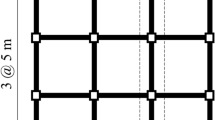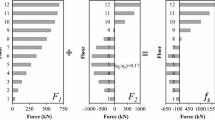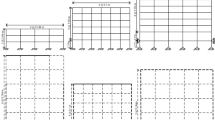Abstract
A setback building has a sudden discontinuity in the frame geometry along the height. This kind of irregularity causes an abrupt discontinuity in stiffness, strength and mass of the building frame. In this study, a total of nineteen mid-rise 9-story steel moment resisting frames with setbacks including the broad range of different geometrical configurations were studied. An eigenvalue analysis was performed to evaluate and scrutinize the dynamic characteristics of setback structures. The effect of geometrical configurations on the seismic responses of setback frames was studied by means of nonlinear response history analysis using a set of far-field ground motion records. Moreover, due to the rapidly increasing use of pushover analysis for the seismic evaluation of structures in recent years, enhanced pushover analyses (EPAs) including the modal pushover analysis, the upper bound pushover analysis, the consecutive modal pushover and the extended N2 methods were implemented as a main part of this study. The findings show that two factors including the location of setback and the degree of setback are of key importance and influence the dynamic characteristics and seismic responses of setback structures. The degree of accuracy of the enhanced pushover analysis methods generally depends on the dynamic characteristics (geometrical configuration) of the setback frames. The largest error in the EPAs in predicting the story drifts generally occurs in a setback frame with a larger amount of the ratio between the effective modal participating mass ratio of the higher modes and that of the first mode.










Similar content being viewed by others
References
Abbasnia R, Davoudi AT (2013) An adaptive pushover procedure based on effective modal mass combination rule. Eng Struct 52:654–666
American Society of Civil Engineers (ASCE) (2007) Seismic rehabilitation of existing buildings. ASCE/SEI 41-06. Reston, Virginia
American Society of Civil Engineers (ASCE) (2010) Minimum design loads for buildings and other structures, ASCE7-10. Reston, Virginia
Antoniou S, Pinho R (2004a) Advantages and limitations of adaptive and non-adaptive force-based pushover procedures. J Earthq Eng 8(4):497–522
Antonio S, Pinho R (2004b) Development and verification of a displacement-based adaptive pushover procedure. J Earthq Eng 8(5):643–661
Aranda G (1984) Ductility demands for R/C frames irregular in elevation. In: Proceedings of the eighth world conference on earthquake engineering. San Francisco, USA
Arnold C (1980) Building configuration: characteristics for seismic design. In: “Proceedings of the Seventh World Conference on Earthquake Engineering, 4. Istanbul, Turkey, 589–592
Arnold C, Elsesser E (1980) Building configuration: problems and solutions. In: Proceedings of the Seventh World Conference on Earthquake Engineering, 4. Istanbul, Turkey, 153–160
Athanassiadou CJ (2008) Seismic performance of R/C plane frames irregular in elevation. Eng Struct 30(5):1250–1261
Building Seismic Safety Council (BSSC) (2000) NEHRP guidelines for the seismic rehabilitation of buildings. FEMA-356, Federal Emergency Management Agency, Washington (DC)
Building Seismic Safety Council (BSSC) (2003) NEHRP recommended provisions for seismic regulations for new buildings and other structures. FEMA-450, Federal Emergency Management Agency, Washington (DC)
Chen WF, Lui EM (2006) Earthquake engineering for structural design. CRC Press, Boca Raton
Chintanapakdee C, Chopra A (2004) Seismic response of vertically irregular frames: response history and modal pushover analyses. J Struct Eng (ASCE) 130(8):1177–1185
Chopra AK, Goel RK (2002) A modal pushover analysis procedure for estimating seismic demands for buildings. Earthq Eng Struct Dyn 31:561–582
Chopra AK, Goel RK, Chintanapakdee C (2004) Evaluation of a modified MPA procedure assuming higher modes as elastic to estimate seismic demands. Earthq Spectra 20(3):757–778
Computers & Structures Inc. (CSI) (2013) SAP2000 NL. Berkeley, CA, U.S.A
Ebrahimi Nezhad M, Poursha M (2015) Seismic evaluation of vertically irregular building frames with stiffness, strength, combined-stiffness-and-strength and mass irregularities. Earthq Struct 9(2):353–373
Fajfar P (2000) A nonlinear analysis method for performance based seismic design. Earthq Spectra 16(3):573–592
Ferracuti B, Pinho R, Savoia M, Francia R (2009) Verification of displacement-based adaptive pushover through multi-ground motion incremental dynamic analyses. Eng Struct 31:1789–1799
Humar J, Wright E (1977) Earthquake response of steel framed multi-storey buildings with setbacks. Earthq Eng Struct Dyn 5(1):15–39
Jan TS, Liu MW, Kao YC (2004) An upper-bound pushover analysis procedure for estimating the seismic demands of high-rise buildings. Eng Struct 26(1):117–128
Kalkan E, Kunnath SK (2006) Adaptive modal combination procedure for nonlinear static analysis of building structures. J Struct Eng 132(11):1721–1731
Karavasilis TL, Bazeos N, Beskos D (2008) Seismic response of plane steel MRF with setbacks: estimation of inelastic deformation demands. J Constr Steel Res 64(6):644–654
Kim S-P, Kurama YC (2008) An alternative pushover analysis procedure to estimate seismic displacement demands. Eng Struct 30:3793–3807
Krawinkler H, Seneviratna GDPK (1998) Pros and Cons of a pushover analysis of seismic performance evaluation. Eng Struct 20(4–6):452–464
Kreslin M, Fajfar P (2011) The extended N2 method taking into account higher mode effects in elevation. Earthq Eng Struct Dyn 40(14):1571–1589
Mao J, Zhai C, Xie L (2008) An improved modal pushover analysis procedure for estimating seismic demands of structures. Earthq Eng Eng Vib 7(1):25–31
Mazzolani FM, Piluso V (1996) Theory and design of seismic resistant steel frames. FN & SPON an Imprint of Chapman & Hall, London
Moehle JP (2006) Seismic analysis, design, and review for tall buildings. Struct Des Tall Spec Build 15(5):495–513
Moghadam AS, Tso W (2000) Pushover analysis for asymmetric and set-back multi-story buildings. In: Proceedings of the 12th world conference on earthquake engineering
National Building Regulations (2008) The Tenth Issue, Building and Housing Research Center, Ministry of Roads and Urban Development
Pacific Earthquake Engineering Research (PEER) Centre (2013) Strong ground motion database. http://peer.berkeley.edu/
Panyakapo P (2014) Cyclic pushover analysis procedure to estimate seismic demands for buildings. Eng Struct 66:10–23
Pinto D, Costa AG (1995) “Influence of Vertical Irregularities on Seismic Response of Buildings”. In: Proceedings of the Tenth European Conference on Earthquake Engineering. A.A. Balkema, Rotterdam
Poursha M, Amini MA (2015) A single-run multi-mode pushover analysis to account for the effect of higher modes in estimating the seismic demands of tall buildings. Bull Earthq Eng 13(8):2347–2365
Poursha M, Samarin ET (2015) The modified and extended upper-bound (UB) pushover method for the multi-mode pushover analysis of unsymmetric-plan tall buildings. Soil Dyn Earthq Eng 71:114–127
Poursha M, Khoshnoudian F, Moghadam AS (2009) A consecutive modal pushover procedure for estimating the seismic demands of tall buildings. Eng Struct 31(2):591–599
Romão X., Costa A, Delgado R (2004) Seismic behaviour of reinforced concrete frames with setbacks. In: Proceedings of the 13th World Conference on Earthquake Engineering, CD ROM. Vancouver
Sarkar P, Prasad AM, Menon D (2010) Vertical geometric irregularity in stepped building frames. Eng Struct 32(8):2175–2182
Shahrooz BM, Moehle JP (1990) Seismic response and design of setback buildings. J Struct Eng 116(5):1423–1439
Shakeri K, Shayanfar MA, Kabeyasawa T (2010) A story shear-based adaptive pushover procedure for estimating seismic demands of buildings. Eng Struct 32:174–183
Soni DP, Mistry BB (2006) Qualitative review of seismic response of vertically irregular building frames. ISET J Earthq Technol Tech Note 43(4):121–132
Standard No. 2800-05 (2005) Iranian code of practice for seismic resistant design of buildings, 3rd edn. Building and Housing Research Centre, Iran
Standard No. 2800 (2012) Iranian code of practice for seismic resistant design of buildings. First draft of the 4th edn. Building and Housing Research Centre, Iran
Sucuoglu H, Gunay MS (2011) Generalized force vectors for multi-mode pushover analysis. Earthq Eng Struct Dyn 40:55–74
Tena-Colunga A (2004) Evaluation of the seismic response of slender, setback RC moment- resisting frame buildings designed according to the seismic guidelines of a modern seismic code. In: 13th world conference on earthquake engineering, Paper no. 2027
Wong CM, Tso WK (1994) Seismic loading for buildings with setbacks. Can J Civ Eng 21(5):863–871
Author information
Authors and Affiliations
Corresponding author
Rights and permissions
About this article
Cite this article
Bohlouli, Z., Poursha, M. Seismic evaluation of geometrically irregular steel moment resisting frames with setbacks considering their dynamic characteristics. Bull Earthquake Eng 14, 2757–2777 (2016). https://doi.org/10.1007/s10518-016-9910-y
Received:
Accepted:
Published:
Issue Date:
DOI: https://doi.org/10.1007/s10518-016-9910-y




